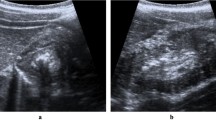Abstract
Objective: A case series study was conducted for two years from 01 June 2002 to 01 June 2004 to study the efficiency of ultrasound guided hydrostatic reduction in the management of intussusception in children.Methods: A total of 25 patients who underwent the procedure were evaluated. All the patients were diagnosed by High Resolution Ultrasonography (HRUSG). Continuous monitoring of the progress of reduction during the procedure was done by HRUSG. 500–1000 ml (average 600 ml) of normal saline was used.Results: 24 out of 25 (96%) intussusceptions were successfully reduced. Average time taken was 15 minutes. All the patients were reviewed after 24 hrs for recurrence. None of them showed recurrence within 24 hrs. No complications were observed.Conclusion: The study concludes that ultrasound guided hydrostatic reduction is a safe, simple and effective method for treatment of intussusception in children.
Similar content being viewed by others
References
Vanessa MW. Intussususception. In Lewis S, Arnold GC, eds.Rob & Smith’s Operative Surgery, Pediatric Surgery, 4th ed, London: Chapman & Hall Medical, 1994;396–397.
Marc CW: Intestinal Obstruction. In RG Russel, NS Williams, & CJK Bulstrode, eds.Bailey & Love’s Short Practice of Surgery, 23rd ed. London: Arnold Publishers, 2000:1067–106.
Hadidi AT, El Shal N. Childhood intussusception: A comparative study of nonsurgical management.J Pediatr Surg 1999;34(2):304–307.
Riebel TW, Nasir R, Weber K. US-guided hydrostatic reduction of intussusception in children.Radiology 1993;188: 513–516.
Choi SO, Park WH, Woo JK. Ultrasound guided water enema: An alternative method of nonoperative treatment for childhood intussusception.J Pediatr Surg 1994;29(4):498–500.
Del-Pozo G, Albillos JC, Tejedor Dea al. Intussusception in children: Current concepts in diagnosis and enema reduction.Radiographics 1999;19:299–319.
Daneman A, Alton DJ. Intussusception: Issues and controversies related to diagnosis and reduction.Radiol Clin North Am 1996;34(4):743–756.
Ugwu BT, Legbo JN, Dakum NKet al. Child hood intussusception: 9 year review.Ann Trop Paediatr 2000, 20(2):131–135.
Swischunk LE, John SD, Swischunk PN. Spontaneous reduction of intussusception: Verification with ultrasound.Radiology 1994;192:269–271.
Mirilas P, Koumanidou C, Vakaki Met al. Sonographic features indicative of hydrostatic reducibility of intestinal intussusception in infancy and early childhood.Eur Radiol 2001;11(12):2576–2580.
Susan DJ, Leonard ES. Pediatric gastrointestinal tract-Intussusception. In: Carol MR, Stephanie RW, Charboneau JW, eds.Diagnostic Ultrasound Vol. II, 2nd ed. St. Louis: Mosby-Year book Inc., 1998:1729–1731.
Lim HK, Bae SH, Lee KHet al. Assessment of reducibility of ileo-colic intussusception in children: Usefulness of color Doppler sonography.Radiology 1994;191:781–785.
Katz M, Phelan E, Carlin JB, Beasly SW. Gas enema for the reduction of intussusception: Relationship between clinical signs and symptoms and outcome.AJR 1993;160:363–366.
Koumanidou C, Vakaki M, Pitroouiakis Get al. Sonographic detection of lymph nodes in the intussusception of infants and young children.AJR 2002;178:444–450.
Crystal P, Hertzanu Y, Farber Bet al. Sonographically guided hydrostatic reduction of Intussusception in children.J Clin Ultrasound 2002;30(6):343–348.
Navarro OM, Daneman A, Chae A. Intussusception: The use of delayed, repeated reduction attempts and the management of intussusception due to pathologic lead points in pediatric patients.AJR 2004;182:1169–1176.
Daneman A, Navarro O. Intussusception, Part 2: An Update on the evolution of management.Pediatr Radiol 2004;34:97–108.
Fecteau A, Flageole H, Nguyen LTet al. Recurrent intussusception: safe use of hydrostatic enema. J Pediatr Surg 1996;31(6):859–861.
Chan K, Chan J, Peh Wet al. Endotoxemia associated with intussusception and its diagnostic and surgical interventions.Pediatr Surg Int 2002;18(8):685–688.
Author information
Authors and Affiliations
Corresponding author
Rights and permissions
About this article
Cite this article
Krishnakumar, Hameed, S. Ultrasound guided hydrostatic reduction in the management of intussusception. Indian J Pediatr 73, 217–220 (2006). https://doi.org/10.1007/BF02825484
Issue Date:
DOI: https://doi.org/10.1007/BF02825484




